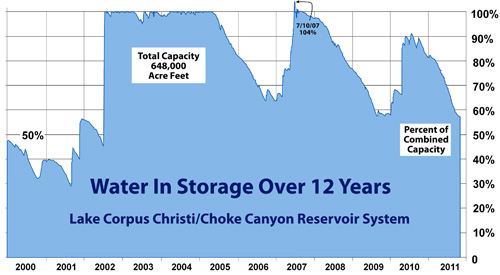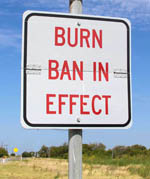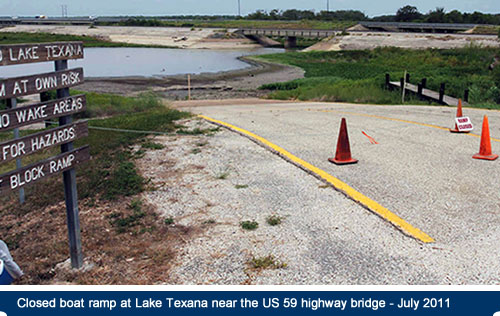October 31, 2011
 Rainfall is in short supply all over Texas this year. Stock ponds are drying up, water wells are going dry and reservoir levels are inching their way down even in the usually wet timber country of East Texas. Many areas including Houston, San Antonio and Austin have been forced to impose water use restrictions on residents. Only Dallas-Fort Worth has had a substantial rain this year but even there most communities have imposed lawn watering and other restrictions.
Rainfall is in short supply all over Texas this year. Stock ponds are drying up, water wells are going dry and reservoir levels are inching their way down even in the usually wet timber country of East Texas. Many areas including Houston, San Antonio and Austin have been forced to impose water use restrictions on residents. Only Dallas-Fort Worth has had a substantial rain this year but even there most communities have imposed lawn watering and other restrictions.
South Texas is no exception to the drought with thousands of square miles of powder dry ranchland in the region. This year's tropical storm season brought no rainfall to the Coastal Bend or to the Nueces River watershed to the west. The continued lack of rain over South Texas, combined with above normal temperatures, have resulted in exceptionally dry and hot weather for several months. The drought is feeding on itself, keeping abnormally dry and hot weather intact. An upper level high is also helping to block tropical systems and curtail thunderstorm development. Thundershowers did blossom on Aug. 25 and 26 with an inch or more of rain in most of the District's service area.
Fortunately rainfall at critical times this spring allowed most Coastal Bend farmers to make something of their crops of grain and cotton. Almost all of the row crop agriculture in the region is "dryland" farming which depends exclusively on rainfall. A small percentage of fields in western San Patricio County receive some irrigation from groundwater wells. The grain and cotton harvests in the area are now essentially complete.
 LAKE TEXANA
LAKE TEXANA
About half of the water used each year by Water District residential, commercial and industrial customers comes from Lake Texana on the Navidad River while the other half comes from the Lake Corpus Christi-Choke Canyon Reservoir System on the Nueces River.
By the end of October the water levels at Lake Texana had dropped to 43% of capacity at 32.5 feet above sea level which is 11.5 feet below the maximum elevation of 44 feet. Most South Texans have driven on US 59 which crosses the very upper reach of Lake Texana, some 11 miles upstream from the Palmetto Bend Dam. The Navidad River Basin is very productive and Lake Texana stays full or near full most of the time. This year, however, minimal rainfall has left motorists on US 59 with a view of mud and grass where they usually see lake waters lapping at the supports under the adjacent railroad bridge. Boat ramps around the lake are high and dry. The photo below was taken July 15th with the lake level at 37.0 feet.
Lake Corpus Christi/Choke Canyon System
Lake Corpus Christi and Choke Canyon are operated as a system to minimize evaporation, maximize water conservation and provide inflows to the Nueces Estuary. As can be seen in the chart above, the combined amount of water in storage in the two reservoir system has not been below 50% since 2002.
Heavy rains in April 2010 increased combined LCC-CCR capacity by a full 20%. More rains in July 2010 added water to both reservoirs which reached their recent peak that month of just over 90% of combined capacity in storage. After another spike from rains in October the lake levels started a slow steady decline through the year-long dry spell. By the end of October 2011 the combined total in storage was 57% of capacity.
With the LCC-CCR system is still above 50% full, customers of the Water District will not face water use restrictions before spring. The coming year could be a different story if there is no uptick in reservoir inflows in the coming months. Based on averages over the past 40 years, September and October are typically the months of highest rainfall in the Corpus Christi Bay Area, but none came this year.
Drought Water Use Restrictions
By contract the San Patricio Municipal Water District and its customer cities comply with the Drought Management Plan adopted by the City of Corpus Christi which manages the region’s water supply system. The plan is tied to the combined amount of water in storage in Choke Canyon and Lake Corpus Christi. It triggers actions at 50%, 40% and 30% of capacity.
The City of Corpus Christi is considering revising the rules before 2012. Here are the current rules:
50% Rule
When the reservoir system storage drops below 50% of total system capacity, the local water provider will issue a public notice to inform water users to begin voluntary conservation measures.
40% Rule
When capacity drops to 40% water providers will implement time of day outdoor watering restrictions. Additionally, the target inflows to Nueces Bay are reduced to 1,200 acre feet per month. Residents and businesses are restricted from using water for irrigation of vegetation between the hours of 10:00 a.m. and 6:00 p.m. No person may: (1) allow water to run off from yards or plants into gutters or streets, (2) allow defective plumbing in a home or business to remain unaddressed or (3) allow water to flow constantly through a tap, hydrant, valve, or otherwise by any user of water connected to the municipal system.
30% Rule
When the reservoir system reach 30% of capacity, the City of Corpus Christi will publish a lawn watering schedule which will restrict lawn watering to specific days. In addition, target inflows to Nueces Bay are reduced to zero.








